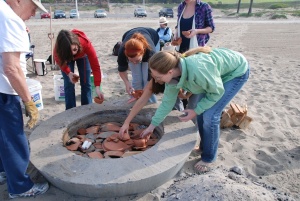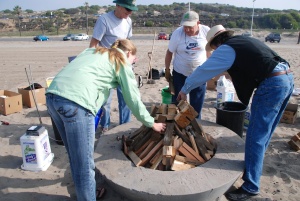Post and pictures by Dawn Lohnas
We went to the Dockweiler State Beach last Saturday to fire our ceramic pinch pots that we made for Prof. David Scott’s “Archaeological Materials: Technology and Characterization” course. We fired them in a pit fire to get a better understanding for this ancient technology.
Here are our vessels before firing…you can see the pit warming up there in the background.
After the initial fire heated up, a layer of ceramic sherds was laid down to insulate the pots from the heat. Then our pots, along with all the other greenware (unfired pieces) were placed in the pit. Another layer of large sherds was placed on top of the greenware, and layer of bisqueware (previously fired ceramics) was placed on top of that. Then we added more wood, and fired it up again!
After firing for a good few hours, and reaching close to 900 degrees celsius, the pottery was ready to be retrieved.
Most everything survived! Success!! Now we all know a little bit more about a technique that has been around for many millennia…Thanks to Don Corbett and Marilyn Beaudry-Corbett, Director of the Ceramics Research Group, at UCLA’s Cotsen Institute of Archaeology for organizing all of this!






